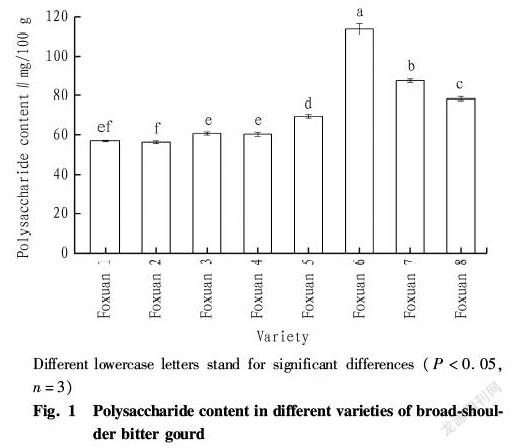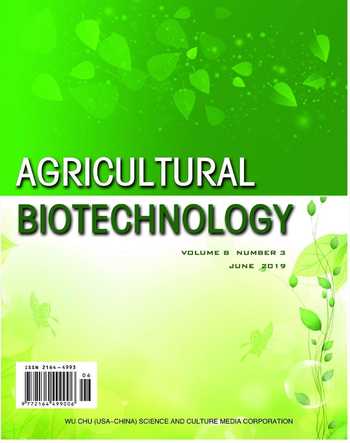Preliminary Study on the Quality Difference of Local Broad-shoulder Bitter Gourd Landraces in Foshan
Qiang LI Jing ZHANG Xiangni LI Zujiang GAO Ruiyi YANG Puxing LIANG


Abstract [Objectives] The study aims to provide important reference for the breeding and research of new varieties of functional broad shoulder bitter gourd.
[Methods] 8 pure varieties of local broad shoulder bitter gourd landraces in Foshan were used as experimental materials, in which polysaccharide, cellulose and vitamin C content were measured.
[Results] Among the 8 varieties of local self selected broad shoulder bitter gourd in Foshan, the polysaccharide content of Foxuan 6 was the highest, up to 113.78 mg/100 (g·FW), which was significantly higher than that of the other 7 varieties. The polysaccharide content of Foxuan 2 was the lowest. The cellulose content of Foxuan 8 was the highest, reaching 24.50 mg/100 (g·FW), which was significantly higher than that of the other 7 varieties. The cellulose content of Foxuan 4 was the lowest. The vitamin C content of Foxuan 5 was the highest, reaching 74.24 mg/100 (g·FW), which was significantly higher than that of the other 7 varieties. The vitamin C content of Foxuan 4 was the lowest, only 7.05 mg/100 (g·FW). In a word, there were big differences between the 8 varieties of broad shoulder bitter gourd in terms of polysaccharide, cellulose and vitamin C content.
[Conclusions] It is possible to make full use of their own quality differences and develop new varieties of functional broad shoulder bitter gourd by means of cross combination.
Key words Foshan; Broad shoulder bitter gourd; Landraces; Quality difference
Bitter gourd (Momordica charantia L.), which belongs to the genus Momordica, Cucurbitaceae, is a medicinal and edible plant. Studies have shown that bitter gourd is rich in bitter gourd polysaccharide, saponin, vitamin C, elaterin and other active substances[1], and they can reduce blood sugar, resist tumor, enhance immunity, and resist inflammation obviously[2].
Materials and Methods
Experimental materials
The 8 varieties of bitter gourd used in the experiment were the pure varieties of local broad shoulder bitter gourd landraces in Foshan, and were named as Fuxuan 1-8. The experiment was carried out in the net shed of Foshan Agricultural Science Institute in Nanshan Town, Sanshui District, Foshan City from 2017 to 2018. These species of bitter gourd were cultivated and managed in the same way.
Measurement data and methods
Bitter gourd was harvested in the harvest period and was measured as a sample. Each variety had three repetitions. The content of polysaccharide, cellulose and vitamin C in bitter gourd was determined by phenol sulfuric acid method, fluorenone colorimetric method, and 2,6 dichlorophenol indophenol titration method respectively.
Data processing
The data obtained from the experiment were processed by Microsoft Excel 2010 software. The variance analysis of the experimental data was performed by SPSS 20.0 software, and Duncans multiple comparison method was used (P<0.05).
Results and Analysis
Polysaccharide content
As shown in Fig. 1, among the 8 varieties of broad shoulder bitter gourd, the polysaccharide content of Foxuan 6 was the highest, reaching 113.78 mg/100 (g·FW), which was significantly higher than that of the other 7 varieties. The polysaccharide content of Foxuan 7 and Foxuan 8 ranked second and third respectively, up to 87.66 and 72.53 mg/100 (g·FW) respectively. The polysaccharide content of Foxuan 2 was the lowest, only 56.26 mg/100 (g·FW).
Cellulose content
Seen from Fig. 2, among the 8 varieties of broad shoulder bitter gourd, the cellulose content of Foxuan 8 was the highest, up to 24.50 mg/100 (g·FW), which was significantly higher than that of the other 7 varieties. The cellulose content of Foxuan 4 was the lowest.
Vitamin C content
Vitamin C, also known as ascorbic acid, is an indispensable vitamin in human life activities. As shown in Fig. 3, there were significant differences between the 8 varieties of broad shoulder bitter gourd in terms of vitamin C content (P<0.05). Among them, the vitamin C content of Foxuan 5 was the highest, reaching 74.24 mg/100 (g·FW), which was significantly higher than that of the other 7 varieties. The vitamin C content of Foxuan 4 was the lowest, only 7.05 mg/100 (g·FW).
Conclusions and Discussion
In this experiment, among the 8 varieties of local self selected broad shoulder bitter gourd in Foshan, the polysaccharide content of Foxuan 6 was the highest, up to 113.78 mg/100 (g·FW), which was significantly higher than that of the other 7 varieties. The polysaccharide content of Foxuan 2 was the lowest. The cellulose content of Foxuan 8 was the highest, reaching 24.50 mg/100 (g·FW) , which was significantly higher than that of the other 7 varieties. The cellulose content of Foxuan 4 was the lowest. The vitamin C content of Foxuan 5 was the highest, reaching 74.24 mg/100 (g·FW), which was significantly higher than that of the other 7 varieties. The vitamin C content of Foxuan 4 was the lowest, only 7.05 mg/100 (g·FW).
Bitter gourd polysaccharide is one of the main bioactive components in bitter gourd. Studies have shown that bitter gourd polysaccharide has the functions of lowering blood sugar, enhancing immunity and anti oxidation[3-4]. The experiment showed that there were big differences between the 8 varieties of broad shoulder bitter gourd in terms of polysaccharide, cellulose and vitamin C content. They can be further used as materials to provide important reference for the breeding and research of new varieties of functional broad shoulder bitter gourd.
References
[1] XIANG CP, WU CY, WANG LP. Analysis and utilization of nutrient composition in bitter gourd[J]. Journal of Huazhong Agricultural University, 2000, 19(4): 388-390. (in Chinese).
[2] JIN LL, TANG T, XING WX. The chemical ingredients and pharmacological properties of Momordica charantia[J]. Health Research, 2015(1): 23-24. (in Chinese).
[3] CHEN HM,LI HX, KAN GS, et al. Correlation study between antioxidant activity and lowering blood glucose of momordica polysaccharide[J]. Science and Technology of Food Industry, 2012, 33(18): 349-354. (in Chinese).
[4] HUANG J, ZHANG MW, ZHANG RF, et al. Comparison of polysaccharide content in different cultivars of Momordica charantia L. and in different tissues and development stages[J]. Acta Horticulturae Sinica, 2008, 35(5): 757-760. (in Chinese).
- 农业生物技术(英文版)的其它文章
- Tissue-specific Expression of Acetolactate Synthase (ALS) Male Sterility-inducing Effect of Tribenur
- Detection of Favorable Alleles for Quality- and Yield-related Traits in Wheat Using a Backcross Population
- Resistance Selection Against Abamectin in Tetranychus cinnabarinus (Boisduval) and Changes in Its Detoxification Enzyme Activity
- Study on Compositions of Grain Starch and SGP-1 Protein in Black Grain Wheat
- Polygenic Heritability of Rose Root Rot Disease Resistance in Offspring of Rosa multiflora
- Efficient Somatic Embryogenesis and Plant Regeneration Through Callus Initiation From Seedling-derived Leaf Materials of Maize (Zea mays L.)

